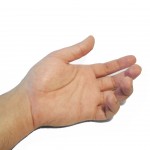IS THE (HAND) FORCE WITH YOU? Work activity and carpal tunnel syndrome
 The relationship between carpal tunnel syndrome (CTS) and work activities remains highly debated among physicians and surgeons. Recent studies provide evidence that essentially splits and clarifies the difference of opinion.
The relationship between carpal tunnel syndrome (CTS) and work activities remains highly debated among physicians and surgeons. Recent studies provide evidence that essentially splits and clarifies the difference of opinion.
CTS is numbness, tingling, weakness, and pain in the hand[1] due to compression of the median nerve in the wrist.
The Journal of Bone and Joint Surgery published a review of recent medical literature[2] and medical presentations[3] addressing hand surgery in a specialty update.[4] Among the review included two large pooled cohort studies[5] that followed 3515 workers from 50 workplaces for up to 7 years. Adjusted for age, gender, sex, etc. the investigators attempted to isolate the effects of hand use on the development and diagnosis of CTS.
The data revealed self-reported and observed forceful hand exertions doubled the risk of CTS. Conversely, repetitive activities with low force and percentage of time in extremes of wrist position were not associated with any increased risk of carpal tunnel syndrome.
The studies indicate forceful hand activities such as operating a jackhammer and riveting are associated with CTS. Low force repetitive activities and sustained periods of wrist flexion or extension, however, did not reveal any association with CTS. The data suggests CTS is unrelated to keyboarding, computer mouse use, and light grasping.
Medical opinion regarding the relationship between light or moderate repetitive workplace hand use and CTS will undoubtedly remain divided. The recent studies, however, provides some support for each side of the debate: CTS is associated with forceful hand use; and unrelated to repetitive, low impact hand activities.
[1] Symptoms typically occur in the wrist, palm, thumb, index, and third fingers, though usually not in the fourth or little fingers.
[2] JBJS summarized hand surgery articles published from June 2013 through July 2014.
[3] JBJS outlined hand surgery materials presented at the 2014 annual meetings of the American Society for Surgery of the Hand (ASSH), the American Association for the Hand (AAHS), and the American Academy of Orthopaedic Surgeons (AAOS).
[4] Amadio, Peter C., What’s New In Hand Surgery, J Bone Joint Surgery Am, 2015; 97:520 (Mar 18, 2015)
[5] Dale AM, et al., Prevalence and incidence of carpal tunnel syndrome in US working populations: pooled analysis of six prospective studies, Scand J Work Environ Health, 2013Sep1;39(5):495 – 505; Harris-Adamson C, et al., Personal and workplace psychosocial risk factors for carpal tunnel syndrome: a pooled study cohort, Occup Eviron Med.2013Aug; 70(8):529-37.
| PLEASE TELL US WHAT YOU THINK OF OUR BLOGS — TAKE A QUICK SURVEY HERE |
